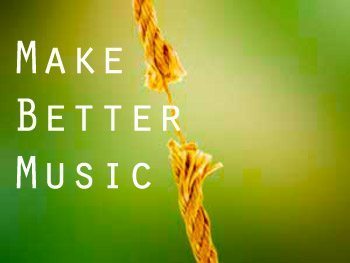This will probably seem like a hair splitting exercise to some, but it’s an issue that I’ve noticed a lot of software-based musicians coming unstuck on.
It’s three things that seem to be tangled up in some peoples minds, and I want to untangle them:
Tempo, rhythm and time signature.
A tempo is always a regular pulse, the heartbeat of the music whether it is obviously audible or not. A tempo is measured in “numbers per amount of time”. You can say two beats per second. You can say 530 beats per half hour – it’s not the sort of instruction that most of us will instinctively have a feel for, but it’s technically precise!
A piece of music does not need to have a tempo. If there is no regular heartbeat that lines up with any important events in the music, then you don’t need to assign it a tempo. To take the opposite point of view, if nothing lines up, then the tempo could be anything..you could put any pulse under the sound and it make no difference.
If a track does have a regular pulse running through it, you can call that the tempo.
Roughly speaking it is the “speed” of the music. If the song gets faster the tempo increases, and vice versa.
Rhythm – here’s where the confusion can set in. I think of tempo and rhythm as different things, although their meanings can overlap. Rhythm is durations of time expressed as sound, and/or gaps between sounds.
They can be regular, occurring at even intervals of time (like a tempo), or they can be uneven and chaotic. Some people regard rhythm as the opposite of a tempo. A tempo is a regular pulse, whereas rhythm might be thought of as an expression of anything other than that regular pulse. I’ll let you ponder that one and come to your own conclusions.
Time signature. This is not a rhythm or a tempo. A time sig is a way of organising hyper-metric durations. Before you start looking at me like an alien, this just means repeated groups of a certain number of notes or a certain duration. They don’t have to repeat, but they most often do…and time signatures eventually lose their meaning if each bar has a different one.
One thing my music teacher was fond of saying was that “a time signature is not a fraction” despite being written like them. Having grown up and pondered it for myself, I think they ARE like fractions, but with one major difference.
If we take as an example, 4/4 time, for simplicities sake. Everyone know that most music is in 4/4. Surprisingly few software musicians know precisely what this means.
In one sense, it IS a fraction:
To quote that source that is utterly impervious to error, Wikipedia:
http://en.wikipedia.org/wiki/Fraction_(mathematics)
… An example is 3/4, in which the numerator, 3, tells us that the fraction represents 3 equal parts, and the denominator, 4, tells us that 4 parts make up a whole.
This basically explains everything you need to know about time signatures…alas it explains it in a way that you’d need a heel of a lot of luck to extrapolate everything accurately.
Yes the top number is the numerator – it says how many “somethings” there is.
The bottom number tells you what those “somethings” are.
So you end up with something that tells you what kind of note you are dealing with, and how many of them are grouped together, as a rule. It’s an organisational thing. They have no bearing on what the music has to sound like. You can write a piece of music down in one tie signature when it is really another. The two versions will sound no different…in theory. In practice however, they might, if real players are involved. Time signatures are mainly a device for a composer to let a player know what sort of patterns she is dealing with.
So there we have it..time sigs are a way of organising the underlying structure of what is going on in the music, tempo is the speed of the repeating, equal pulse that the music runs along, and rhythm is temporal deviation from that pulse.
Let the disagreements begins!
Make Better Music is updated every Tuesday. To catch up on the series search for ‘Dave Graham’.
Image: Francesco Marino / FreeDigitalPhotos.net

David Learnt composition (harmony, counterpoint and orchestration) to degree level through studying Schoenbergs Fundamentals of Musical Composition, the classic text on twentieth century harmony by Vincent Persichetti, Henry Mancini’s Sounds and Scores, Rimsky-Korsakov’s excellent books on orchestration as well as studying any scores that intrigued me. He is a founder member of two bands, avant pop duo Cnut, and orchestral doombience outfit Regolith, and have performed across Europe with them.



















